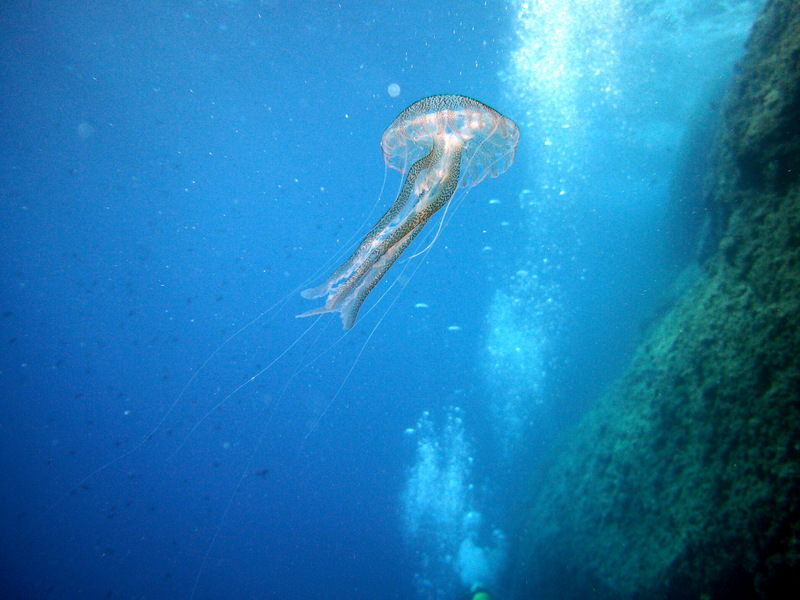Pelagia noctiluca
From Wikipedia, the free encyclopedia
Order: Semaeostomeae
Family: Pelagiidae
[Photo] Mauve Stinger Jellyfish (Pelagia noctiluca). Date 15 october 2007. Author http://commons.wikimedia.org/wiki/User:Yoruno
Pelagia noctiluca (Forsskal, 1775) is a jellyfish, belonging to the family Pelagiidae.
In Greek Pelagia means “of the sea”, nocti stands for night and luca means light thus Pelagia noctiluca can be described as a marine organism with the ability to glow in the dark.
This species of jellyfish commonly known as mauve stinger, amongst many other common names, is widely distributed in all warm and temperate waters such as the Mediterranean Sea, Red Sea and Atlantic Ocean. However there were also some sightings of this species in Hawaii. In an unprecedented event on November 21, 2007, an enormous 10-square mile swarm of billions of these jellyfish wiped out a 100,000-fish salmon farm in Northern Ireland.
Classification of P. noctiluca
P. noctiluca is an animal, thus non-photosynthetic, multicellular eukaryote. Being a cnidarian it is diploblastic, having an ectoderm and endoderm separated by an ectodermally derived mesoglea that can be cellular or acellular.
The body is radially symmetrical. There is only one body cavity (coelenteron) known as the gastrovascular cavity. This is a primitive gut or digestive cavity with only one opening that acts as a mouth and anus. Being radially symmetrical it has no head and thus no centralized nervous system. The nervous system present is primitive, consisting of a simple net composed of naked and largely non-polar neurons. In addition P. noctiluca also lacks a gaseous exchange, excretory and circulatory system. However cnidaria have evolved cnidae, cells which serve for a variety of functions that include prey capture, defense, locomotion and attachment. When fully formed cnidae are called cnidocytes. When stimulated the cnidae secrete nematocyst toxins that are biological poisons.
P. noctiluca is a scyphozoan and adapted to a pelagic mode of life. This class of organisms has adapted in such a way that the polyp stage is shortened or in some cases such as that of the genus Pelagia this is absent, thus direct development exists. These organisms have a well developed manubrium, proboscis-like structure bearing the mouth. Also the mesoglea is relatively thickened and well developed being highly visible in the organism. Sense organs present in the scyphomedusae appear in notches and alternate between tentacles. Cnidae are present in the epidermis and gastrodermis.
Semaeostomates are mainly distinguished from the other orders by having simple oral arms with frilled or folded lips. The order semaestomae comprises three families: Pelagiidae, Cyaneidae,and Ulmaridae, distinguishable by the following characters:
1. Gastrovascular cavity divided by radial septa into rhopalar and tentacular pouches.
a. Pouches simple and unbranched - Pelagiidae
b. Pouches branched - Cyaneidae
2. Gastrovascular system in form of unbranched and branching canals, or with anastomosing radial canals - Ulmaridae
In addition the Pelagiidae has no ring canal, marginal tentacles arising from umbrella margin. There are three genera in this family.
Structure and adaptations of Pelagia noctiluca
P. noctiluca has eight marginal tentacles alternating with eight marginal sense organs. This species reproduces sexually. Four gonads arise as elongated endodermal proliferations, developing into a ribbon-like folds in the interradial sectors of the stomach wall slightly distal to the rows of gastric filaments. Male and female gonads vary only slightly and the main difference is the thickness of the follicle. Eggs are laid between 12pm and 2pm in December in Mediterranean specimens as described by Metschnikoff (1886). After 3 days the egg develops in a planula at this stage movement is only done by ciliary action. After 7 days planulae develop into ephyra which develop into young medusa after a month.
Feeding reactions were studied by Bozler (1926), where a piece of food was given to the marginal tentacle, the tentacle contracted quickly. There was a slow contraction of the coronal muscle which brought the tentacle nearer to the mouth. The food was grasped by the lip of one of the oral arm and transported slowly along until it reached the stomach. They were found to feed on Thalia democratica, however they are found mainly to feed by taking food particle by the amoeboid process of the endoderm cells, thus being suspension feeders.
Movement is caused when the medusa pulsates, the marginal tentacles are contracted straightened and stiffened. Pulsation was found to be optimal between 8° to 26°C. Movement is only restricted vertically and thus P. noctiluca are carried in large swarms by currents.
As its name implies P. noctiluca has luminescing power. Light is given in the form of flashes when the medusa is stimulated by turbulence created by a ship’s motion or by waves. This flashing is only of gradual duration and gradually fades.
http://en.wikipedia.org/wiki/Pelagia_noctiluca
| The text in this page is based on the copyrighted Wikipedia article shown in above URL. It is used under the GNU Free Documentation License. You may redistribute it, verbatim or modified, providing that you comply with the terms of the GFDL. |
|

